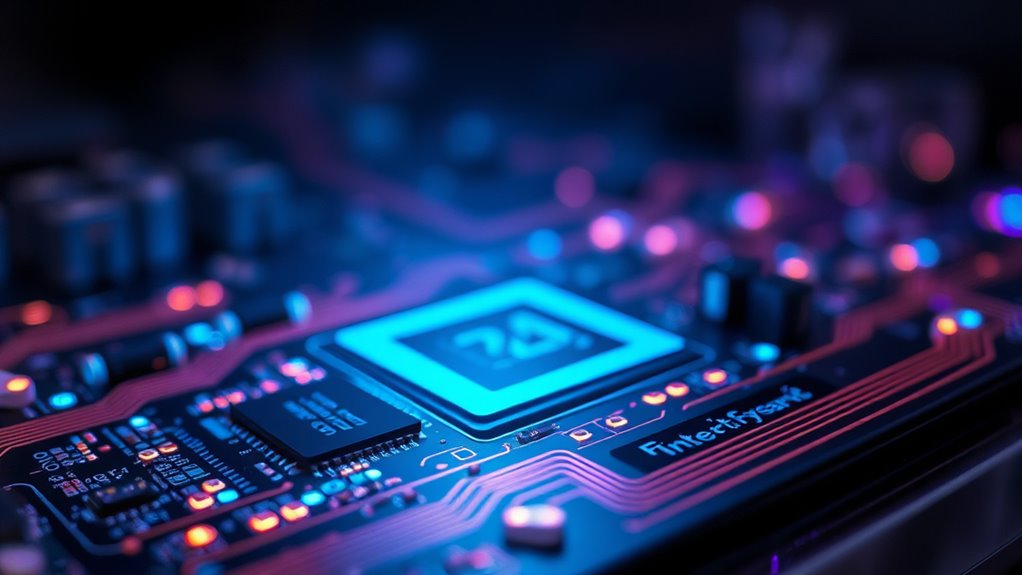Quantum-resistant cryptography helps protect blockchain networks from future quantum computers that could break current encryption methods like RSA and ECC. By adopting post-quantum algorithms, such as lattice-based or hash-based schemes, you can guarantee your data remains secure even as quantum technology advances. Combining quantum key exchange with these new techniques makes transactions more tamper-proof and trustworthy. If you want to understand how these methods secure your blockchain, there’s more to discover beyond the basics.
Key Takeaways
- Quantum-resistant algorithms, like lattice-based cryptography, are being integrated into blockchain to prevent quantum attacks.
- Quantum Key Distribution (QKD) enhances secure communication channels for blockchain transactions.
- Combining post-quantum algorithms with quantum key exchange creates robust, future-proof blockchain security.
- Transitioning to quantum-safe cryptography is essential to maintain blockchain integrity against emerging quantum threats.
- Early adoption of quantum-resistant techniques ensures data confidentiality and tamper-proof operations in blockchain networks.

Have you ever wondered what happens to our digital security when quantum computers become powerful enough to break current encryption methods? The answer lies in the emerging field of quantum-resistant cryptography, which aims to safeguard data against future quantum threats. Traditional cryptographic systems, like RSA and ECC, rely on the difficulty of factoring large numbers or solving discrete logarithms. However, quantum algorithms such as Shor’s algorithm threaten these foundations, potentially rendering today’s encryption obsolete. To counter this, researchers are developing post quantum algorithms designed specifically to resist quantum attacks. These algorithms use mathematical structures that remain secure even when faced with the computational power of quantum computers. They involve lattice-based cryptography, hash-based schemes, and other approaches that don’t rely on the problems vulnerable to quantum algorithms. This shift is essential for blockchain technology, which depends heavily on cryptographic signatures and secure key exchanges to validate transactions and maintain integrity.
Quantum key exchange, particularly protocols like Quantum Key Distribution (QKD), offers a promising solution for secure communication in a quantum future. Unlike classical key exchange methods, which can be compromised by quantum algorithms, quantum key exchange leverages the principles of quantum mechanics to generate and share encryption keys securely. When a sender and receiver use quantum protocols, any eavesdropping attempt can be detected, ensuring that the key remains private. This capability is indispensable for blockchain systems, where ensuring the confidentiality and authenticity of data is paramount. Integrating quantum key exchange into blockchain networks could ensure that transaction data remains tamper-proof and resistant to future quantum attacks. Combining these quantum-safe key exchange methods with post quantum algorithms creates a robust defense, making certain the blockchain’s security remains intact regardless of technological advances. Additionally, the development of portable and scalable quantum hardware is crucial for deploying these quantum-resistant solutions widely and effectively.
The shift to quantum-resistant cryptography isn’t just about adopting new algorithms; it’s about future-proofing digital infrastructure. As quantum computers advance, the urgency to replace vulnerable algorithms increases. Blockchain networks must incorporate these quantum-safe techniques to maintain their security and trustworthiness. While the full realization of quantum resistance is still evolving, early adoption of post quantum algorithms and quantum key exchange protocols can help bridge the gap. By doing so, you can ensure that your digital transactions remain secure and your data protected against the quantum era’s challenges. Staying ahead in this technological race means understanding these emerging cryptographic methods and actively integrating them into your systems before quantum threats become reality.
Frequently Asked Questions
How Soon Will Quantum Computers Threaten Current Blockchain Security?
Quantum computers might threaten current blockchain security within the next 10 to 20 years, based on the quantum timeline. As they grow more powerful, they could crack existing cryptography standards, putting your digital assets at risk. However, researchers are developing quantum-resistant cryptography standards to counter this threat. Staying informed and adopting these new standards early can help protect your blockchain transactions from future quantum attacks.
What Are the Main Challenges in Implementing Quantum-Resistant Algorithms?
Did you know that developing quantum-resistant algorithms can increase computational complexity by up to 50 times? You’ll face challenges like managing larger keys, which complicates storage and transmission, and ensuring algorithms are secure against new attack vectors. Additionally, balancing algorithm complexity with practicality becomes tricky, as overly complex solutions can hinder performance. Effective key management also demands new protocols to protect keys against quantum threats, making implementation more intricate.
Will Quantum-Resistant Cryptography Increase Blockchain Transaction Times?
Yes, quantum-resistant cryptography can increase blockchain transaction times. You’ll notice a rise in computational overhead since these algorithms require more processing power, which can slow down transaction validation. Additionally, network latency may increase as nodes take longer to verify complex cryptographic proofs. This means your transactions might take slightly longer to confirm, but the enhanced security against future quantum threats makes the trade-off worthwhile.
Are There Existing Blockchain Platforms Already Using Quantum-Resistant Methods?
Imagine a blockchain platform like IBM’s Quantum Safe, which already uses post-quantum algorithms to enhance security. Yes, some platforms are adopting quantum-resistant methods to prepare for future threats. As blockchain adoption grows, developers are integrating these algorithms now to safeguard data. This proactive approach helps make certain your transactions stay secure against quantum attacks, creating a more resilient infrastructure for the future.
How Does Quantum-Resistant Cryptography Impact User Privacy and Anonymity?
Quantum-resistant cryptography enhances your privacy by protecting your data from future quantum attacks, ensuring your transactions remain secure. It strengthens anonymity by safeguarding your identity and transaction details, making it harder for outsiders to trace your activity. With quantum privacy measures, you gain greater confidence in the privacy of your blockchain interactions. Overall, it provides a vital layer of anonymity enhancement, securing your digital footprint against emerging quantum threats.
Conclusion
As you stand on the brink of a quantum-powered future, remember that implementing quantum-resistant cryptography is like fortifying your digital fortress against an unstoppable storm. It’s your shield in the swirling fog of technological change, ensuring your blockchain remains unbreakable. By embracing these defenses now, you’re planting a sturdy flag on a mountain of resilience, ready to weather the wild, unpredictable winds of quantum advancements. Stay prepared, stay secure, and let your blockchain stand tall amid the storm.








